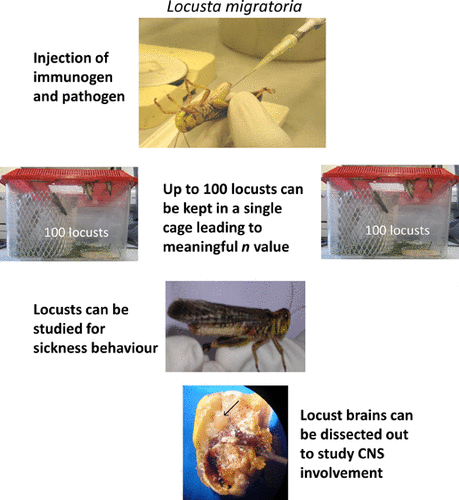当前位置:
X-MOL 学术
›
ACS Pharmacol. Transl. Sci.
›
论文详情
Our official English website, www.x-mol.net, welcomes your
feedback! (Note: you will need to create a separate account there.)
Locusts: A Model to Investigate Human Disease and Sickness Behavior
ACS Pharmacology & Translational Science ( IF 4.9 ) Pub Date : 2020-10-08 , DOI: 10.1021/acsptsci.0c00151 Ruqaiyyah Siddiqui 1 , Naveed Ahmed Khan 1
ACS Pharmacology & Translational Science ( IF 4.9 ) Pub Date : 2020-10-08 , DOI: 10.1021/acsptsci.0c00151 Ruqaiyyah Siddiqui 1 , Naveed Ahmed Khan 1
Affiliation

|
Traditionally, vertebrate models have been utilized and are viewed as more pertinent; however, we propose the application of an invertebrate model such as locusts to study human disease and sickness behavior at an early phase of research. This model has numerous benefits, namely, expense, swiftness, procedural convenience, and ethical acceptance. For example, the injection of immunogen-induced anorexia behavior in rats and locusts in vivo are analogous. Moreover, the presence of a brain barrier in locusts reveals remarkable similarities in molecular methods utilized by E. coli K1 to traverse the central nervous system of rats and locusts, consequently providing a worthwhile model to investigate pathogenesis. The presence of cytokines in these insects and presence of a brain barrier (which is physiologically relevant to human blood–brain barrier) makes it a relevant model in determining disease mechanisms and invasion of the brain by central nervous system pathogens.
中文翻译:

蝗虫:研究人类疾病和疾病行为的模型
传统上,脊椎动物模型已被使用并且被认为更相关。然而,我们建议在研究的早期阶段应用蝗虫等无脊椎动物模型来研究人类疾病和疾病行为。这种模式有很多好处,即费用高、速度快、程序方便和道德接受。例如,注射免疫原在大鼠和蝗虫体内引起的厌食行为是类似的。此外,蝗虫脑屏障的存在揭示了大肠杆菌使用的分子方法的显着相似性K1 穿过大鼠和蝗虫的中枢神经系统,因此提供了一个有价值的模型来研究发病机制。这些昆虫中细胞因子的存在和脑屏障的存在(与人类血脑屏障在生理上相关)使其成为确定疾病机制和中枢神经系统病原体入侵大脑的相关模型。
更新日期:2020-12-12
中文翻译:

蝗虫:研究人类疾病和疾病行为的模型
传统上,脊椎动物模型已被使用并且被认为更相关。然而,我们建议在研究的早期阶段应用蝗虫等无脊椎动物模型来研究人类疾病和疾病行为。这种模式有很多好处,即费用高、速度快、程序方便和道德接受。例如,注射免疫原在大鼠和蝗虫体内引起的厌食行为是类似的。此外,蝗虫脑屏障的存在揭示了大肠杆菌使用的分子方法的显着相似性K1 穿过大鼠和蝗虫的中枢神经系统,因此提供了一个有价值的模型来研究发病机制。这些昆虫中细胞因子的存在和脑屏障的存在(与人类血脑屏障在生理上相关)使其成为确定疾病机制和中枢神经系统病原体入侵大脑的相关模型。











































 京公网安备 11010802027423号
京公网安备 11010802027423号